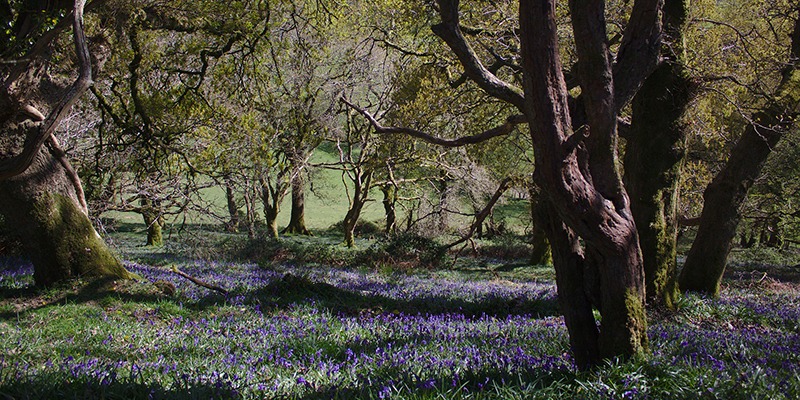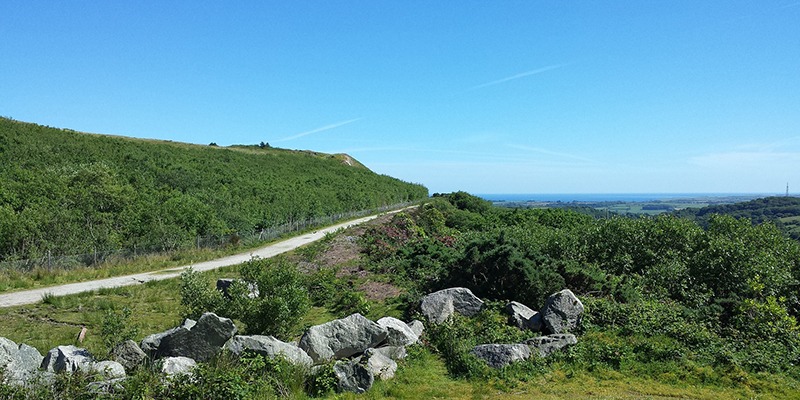
Discover the rolling hills, ancient sites, dramatic coastlines and world-class beaches of South West England by walking the region’s three national trails.
Cotswold Way
The Cotswold Way spans the length of the Cotswolds Area of Outstanding Natural Beauty from the elegant market town of Chipping Campden down to the World Heritage Site City of Bath. The route traces the edge of the Cotswold escarpment, offering spectacular views out over the River Severn across to the Malvern Hills. Along the way, you’ll pass through rolling pastures, beech forests and enchanting villages built from the local amber-tinted limestone. Notable historic sites that line the trail include the Neolithic burial chamber at Belas Knap, the turrets towers and gardens of Sudeley Castle, and the romantic ruins of Hailes Abbey.
Although there are some steep climbs along the Cotswold Way, as long as you have a reasonable level of fitness, you should have no trouble walking any section of its length. Thanks to clear and frequent signposting, navigating the route is easy, but that being said, bringing a map is never a bad idea. The trail can be walked at any time of year, though the colder months are typically when you can gaze over the views from the escarpment at their clearest. Visit during late spring to early summer if you want to stroll through the Wolds in bloom.
The Ridge Way
Popularly known as ‘Britain’s oldest road,’ The Ridge Way has been etched into the chalk hills of south-central England by the wandering feet of travellers since pre-recorded history. Even today, walk along it, and you’ll find its surprising remoteness and the many stone, bronze, and iron-age monuments that line the way create an impression of stepping back into a mysterious bygone age.
The route begins at the World Heritage Site of Avebury in Wiltshire, a village partially encircled by the largest megalithic stone circle in the world. From there, it leads up onto and along the hilltop ridge that lends the trail its name. West of the Thames, the route passes through the North Wessex Downs Area of Outstanding Natural Beauty, a landscape of wide-open, sparsely populated chalk down-land. The ancient treasures you’ll pass during this part of the walk include huge depictions of white horses gleaming from the green hillsides.
After crossing east of the Thames, you’ll enter the Chiltern Hills Area of Outstanding Natural Beauty. From here on, the hills begin to thicken with woodland. As you walk among The Chilterns, you’ll pass through a series of nature reserves home to rare wildflowers and endangered butterflies. The Ridge Way reaches its end at Ivinghoe Beacon, a prominent hill northwest of London with amazing panoramic views of the surrounding countryside.
The Ridge Way is an enjoyable walk all year round. But spring, summer and autumn are when you’ll find the local plants and wildlife full of vigour and walking conditions at their best. The forest floors engulfed by a sea of bluebells is a magical sight you’ll only catch during May. The route is well signposted, but you might want to bring a map along, just in case.
South West Coast Path
The South West Coast Path traces the sea-facing edge of the entire South West peninsula. At 630 miles, it the longest National Trail in England. The Path starts in Minehead in Somerset then runs along the Coast of Exmoor, along the north coast of Devon, and round the sea-facing edge of Cornwall. From there, it crosses the mouth of the River Tamar, continues along the south coast of Devon into Dorset, finally reaching its end at Poole Harbour.
The route consists, in almost its entirety, of awe-inspiring coastal scenery including some of the UK’s most heavenly beaches. Given its length, The South West Coast Path is a wonderful challenge for lovers of long-distance trekking. But if walks that span hundreds of miles don’t feature on your agenda, you’ll be happy to learn that, as with the other two National Trails in South West England, people commonly opt to walk shorter sections of this trail.
Each season unveils a different shade of the South West Coast Path. In Spring, you’ll see lambs frolicking in the fields. Come summer, the moors of the northern coastal sections are speckled with the purple and gold of blooming heather and gorse. By autumn, the skies are filled with great flocks of migrating birds. Winter is the time to witness the awesome power of stormy waves crashing against the cliffs.
All the National Trails in South-West England can be joined and left at any point. We have mentioned the typical direction in which each of the three are walked, but they’re just as enjoyable when travelled in the opposite direction.
Where to stay in South West England
Stay in a holiday home on a 5 star rated park near the start of the Cotswolds Way, Chipping Campden. You’re welcome to bring your tent, tourer or caravan to this park on the edge of the Chiltern Hills. Holiday in your tent, tourer or motorhome on a multi award-winning park in Cornwall.
Find thousands more campsites across the UK.








